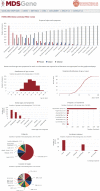MDSGene: Closing Data Gaps in Genotype-Phenotype Correlations of Monogenic Parkinson's Disease
- PMID: 30584170
- PMCID: PMC6311364
- DOI: 10.3233/JPD-181505
MDSGene: Closing Data Gaps in Genotype-Phenotype Correlations of Monogenic Parkinson's Disease
Abstract
Given the rapidly increasing number of reported movement disorder genes and clinical-genetic desciptions of mutation carriers, the International Parkinson's Disease and Movement Disorder Society Gene Database (MDSGene) initiative has been launched in 2016 and grown to become a large international project (http://www.mdsgene.org). MDSGene currently contains >1150 variants described in ∼5700 movement disorder patients in almost 1000 publications including monogenic forms of PD clinically resembling idiopathic (PARK-PINK1, PARK-Parkin, PARK-DJ-1, PARK-SNCA, PARK-VPS35, PARK-LRRK2), as well as of atypical PD (PARK-SYNJ1, PARK-DNAJC6, PARK-ATP13A2, PARK-FBXO7). Inclusion of genes is based on standardized published criteria for determining causation. Clinical and genetic information can be filtered according to demographic, clinical or genetic criteria and summary statistics are automatically generated by the MDSGene online tool. Despite MDSGene's novel approach and features, it also faces several challenges: i) The criteria for designating genes as causative will require further refinement, as well as time and support to replace the faulty list of 'PARKs'. ii) MDSGene has uncovered extensive clinical data gaps. iii) The quickly growing body of clinical and genetic data require a large number of experts worldwide posing logistic challenges. iv) MDSGene currently captures published data only, i.e., a small fraction of the available information on monogenic PD available. Thus, an important future aim is to extend MDSGene to unpublished cases in order to provide the broad data base to the PD community that is necessary to comprehensively inform genetic counseling, therapeutic approaches and clinical trials, as well as basic and clinical research studies in monogenic PD.
Keywords: MDSGene; Parkinson’s disease; data gaps; database; genotype-phenotyp correlation.
Figures

Similar articles
-
Genotype-phenotype relations for the Parkinson's disease genes SNCA, LRRK2, VPS35: MDSGene systematic review.Mov Disord. 2018 Dec;33(12):1857-1870. doi: 10.1002/mds.27527. Epub 2018 Oct 24. Mov Disord. 2018. PMID: 30357936
-
Genotype-Phenotype Relations for the Parkinson's Disease Genes Parkin, PINK1, DJ1: MDSGene Systematic Review.Mov Disord. 2018 May;33(5):730-741. doi: 10.1002/mds.27352. Epub 2018 Apr 11. Mov Disord. 2018. PMID: 29644727
-
Therapies for Genetic Forms of Parkinson's Disease: Systematic Literature Review.J Neuromuscul Dis. 2021;8(3):341-356. doi: 10.3233/JND-200598. J Neuromuscul Dis. 2021. PMID: 33459660 Free PMC article.
-
'Atypical' Parkinson's disease - genetic.Int Rev Neurobiol. 2019;149:207-235. doi: 10.1016/bs.irn.2019.10.011. Epub 2019 Nov 25. Int Rev Neurobiol. 2019. PMID: 31779813 Review.
-
Structural genomic variations and Parkinson's disease.Minerva Med. 2017 Oct;108(5):438-447. doi: 10.23736/S0026-4806.17.05246-6. Epub 2017 May 25. Minerva Med. 2017. PMID: 28541025 Review.
Cited by
-
Levodopa-responsive dystonia caused by biallelic PRKN exon inversion invisible to exome sequencing.Brain Commun. 2021 Sep 6;3(3):fcab197. doi: 10.1093/braincomms/fcab197. eCollection 2021. Brain Commun. 2021. PMID: 34514401 Free PMC article.
-
Mitochondrial Mechanisms of LRRK2 G2019S Penetrance.Front Neurol. 2020 Aug 25;11:881. doi: 10.3389/fneur.2020.00881. eCollection 2020. Front Neurol. 2020. PMID: 32982917 Free PMC article.
-
Genetics of synucleins in neurodegenerative diseases.Acta Neuropathol. 2021 Apr;141(4):471-490. doi: 10.1007/s00401-020-02202-1. Epub 2020 Aug 1. Acta Neuropathol. 2021. PMID: 32740728 Review.
-
Glucocerebrosidase (GBA) gene variants in a multi-ethnic Asian cohort with Parkinson's disease: mutational spectrum and clinical features.J Neural Transm (Vienna). 2022 Jan;129(1):37-48. doi: 10.1007/s00702-021-02421-0. Epub 2021 Nov 15. J Neural Transm (Vienna). 2022. PMID: 34779914
-
Understanding monogenic Parkinson's disease at a global scale.medRxiv [Preprint]. 2024 Apr 9:2024.03.12.24304154. doi: 10.1101/2024.03.12.24304154. medRxiv. 2024. Update in: Mov Disord. 2024 Oct;39(10):1868-1873. doi: 10.1002/mds.29925. PMID: 38529492 Free PMC article. Updated. Preprint.
References
-
- Grunewald A, Kasten M, Ziegler A, Klein C (2013) Next-generation phenotyping using the parkin example: Time to catch up with genetics. JAMA Neurol 70, 1186–1191. - PubMed
-
- Marras C, Lang A, van de Warrenburg BP, Sue CM, Tabrizi SJ, Bertram L, Mercimek-Mahmutoglu S, Ebrahimi-Fakhari D, Warner TT, Durr A, Assmann B, Lohmann K, Kostic V, Klein C (2016) Nomenclature of genetic movement disorders: Recommendations of the international Parkinson and movement disorder society task force. Mov Disord 31, 436–457. - PubMed
-
- Lill CM, Mashychev A, Hartmann C, Lohmann K, Marras C, Lang AE, Klein C, Bertram L (2016) Launching the movement disorders society genetic mutation database (MDSGene). Mov Disord 31, 607–609. - PubMed
Publication types
MeSH terms
Substances
LinkOut - more resources
Full Text Sources
Medical
Molecular Biology Databases
Miscellaneous

